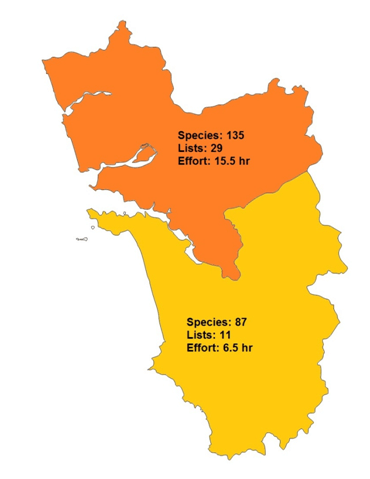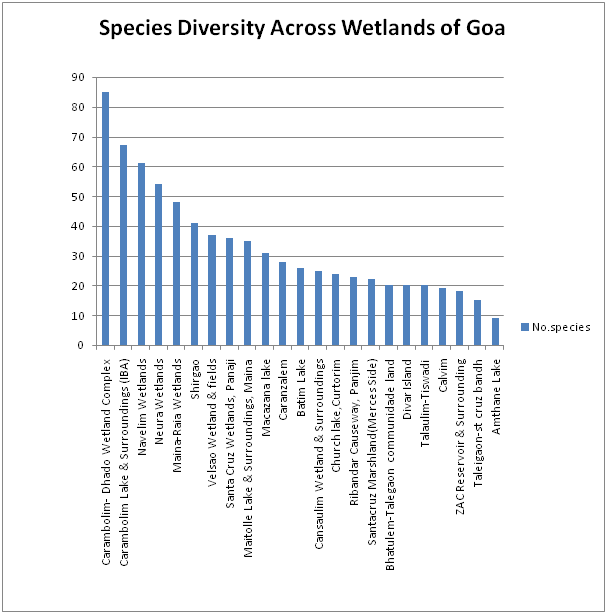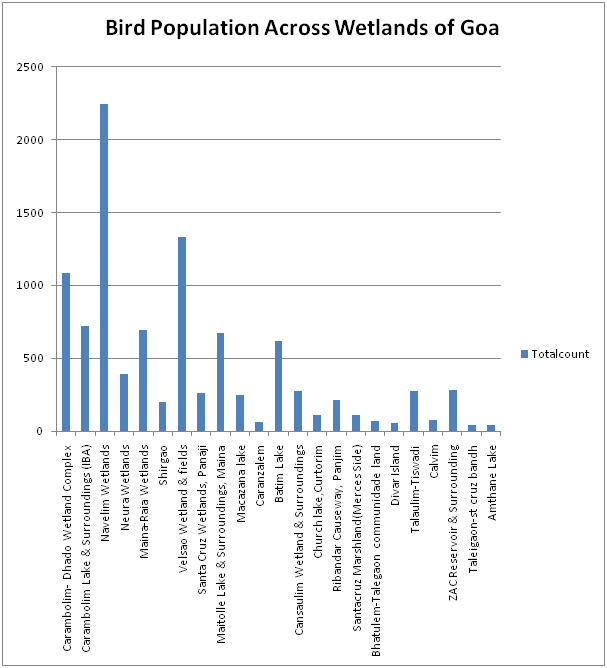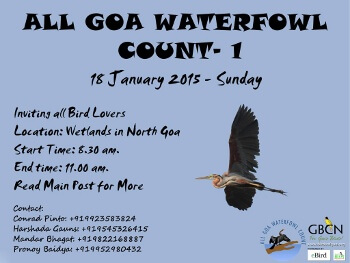
- This event has passed.
All Goa Waterfowl Count
18 Jan 2015
The first All Goa Waterfowl Count (AGWC) was held in two phases, on 18th January 2015 covering North Goa and 25th January 2015 covering South Goa. Teams comprising of expert birders and volunteers covered important wetlands in the two districts of the State on both the days conducting total bird counts. The count started simultaneously at all the selected wetlands on the appointed days. The aim of the AGWC is to systematically conduct surveys of wetlands of importance in the state which are host for migratory bird populations and to understand the the waterfowl population of the state at a base level.
The All Goa Waterfowl Count 2015 concluded with a total of 22 hours of observations being made throughout the state, 15.5 hours in North Goa and 6.5 hours in South Goa. An overall summary of the results is presented below.
Table 1. Summary of Results
|
Species Recorded |
144 |
|
Minutes of Observation |
1320 |
|
Birds Counted |
9922 |
|
Complete lists Submitted |
42 |
|
Participant Birders |
27 |
The count was conducted in the two districts and the distributions of parameters in these two districts are shown below.
Fig. 2 Distribution of Species Count and Effort from sites in two districts of Goa

Table 2. Wetlands Covered in North Goa District
|
Sl. No. |
Name of Wetland |
Hours of effort |
|
1 |
Navelim Wetlands |
3 |
|
2 |
Carambolim Lake and Surrounding |
1 |
|
3 |
Carambolim- Dhado Wetland Complex |
½ |
|
4 |
Batim Lake |
½ |
|
5 |
St. Cruz Wetland |
1 |
|
6 |
Neura Wetland |
1 ½ |
|
7 |
Shirgao Wetland |
1 ½ |
|
8 |
Amthane Lake |
½ |
|
9 |
Caranzalem Wetland |
1 |
|
10 |
Raibandar |
½ |
|
11 |
St.Cruz-Merces Wetland |
½ |
|
12 |
Calvim Wetland |
2 |
|
13 |
Taligaon Wetland |
½ |
|
14 |
Talaulim Wetland |
½ |
|
15 |
Bhatulem-Taligaon |
½ |
|
16 |
Divar Island |
½ |
Table 3. Wetlands Covered in South Goa District
|
Sl. No. |
Name of Wetland |
Hours of effort |
|
1 |
Maina- Raia Wetland |
1 ½ |
|
2 |
Velsao Wetland |
1 ½ |
|
3 |
Church Lake- Curtorim |
1 |
|
4 |
Macazana Lake |
½ |
|
5 |
Cansaulim Wetland |
½ |
|
6 |
Maitolle Lake- Maina |
1 |
|
7 |
ZAC Reservoir |
½ |
Table 4 provides the list of the Threatened species as per IUCN classification recorded during the census. Except the Eurasian Curlew and Pallid Harrier which are both Near Threatened species, all other threatened birds associated with wetlands which have been previously reported from the state have been recorded during the census.
Table 4. Red Data Species reported from AGWC 2015
|
Species |
IUCN Status 2014 |
Migration Status |
Sites |
|
Woolly-necked Stork | Ciconia episcopus |
VU |
M |
Cansaulim Wetland, Batim Lake, Bhatulem-Taligaon, St. Cruz Wetland, Carambolim Lake, Divar Island, Calvim, Shirgaon |
|
Lesser Adjutant | Leptoptilos javanicus |
VU |
R/M |
Neura Wetland, Carambolim- Dhado Wetland, Talaulim |
|
Greater Spotted Eagle | Clanga clanga |
VU |
M |
Batim Lake, Carambolim- Dhado Wetland, Shirgaon |
|
Indian Spotted Eagle | Clanga hastata |
VU |
M |
Maina- Raia Wetland, Batim Lake, |
|
Black-headed Ibis | Threskiornis melanocephalus |
NT |
M |
Neura Wetland, Carambolim- Dhado Wetland, St.Cruz-Merces Wetland, Navelim Wetland, Calvim, Shirgaon |
|
River Tern | Sterna aurantia |
NT |
M |
Macazana Lake, Maitolle Lake- Maina, Church Lake- Curtorim, Carambolim- Dhado Wetland, Raibandar, Amthane Lake |
|
Oriental Darter | Anhinga melanogaster |
NT |
R |
Church Lake- Curtorim, Velsao Wetland, Talaulim, Carambolim Lake |
|
Painted Stork | Mycteria leucocephala |
NT |
M |
Carambolim- Dhado Wetland, Navelim Wetland |
|
Black-tailed Godwit | Limosa limosa |
NT |
M |
Carambolim- Dhado Wetland |
(VU- Vulnerable; NT- Near Threatened; R- Resident; M- Migrant)
The Woolly-necked Stork (VU) was recorded from eight of the 23 wetlands surveyed while Black-headed Ibis (NT) and River Tern (NT) were recorded from six of the 23 wetlands surveyed. Of the 23 wetlands, only Carambolim Lake has been designated as an Important Bird Area in Goa (IN-GA-02) till date.
Fig. 3: Bar Graph showing Species Diversity across Wetlands of Goa

Fig. 4: Bar Graph showing Bird Population (Total Count) across Wetlands of Goa

The above two charts give a fairly good idea of the status of the different wetlands across the state. The Carambolim- Dhado Wetland Complex in North Goa seems to have good species diversity with 85 species (Total Count) reported from the site, while Navelim Wetland in North Goa seems to hold a good bird population (2238 individuals), majority of them being waterbirds.
The Indian Pond Heron (Ardeola grayii) and Brahminy Kite (Haliastur indus) were found to be the most common resident birds of wetlands across the state, with these species being reported from 19 of the 23 wetlands surveyed, while the resident Lesser Whistling-Duck (Dendrocygna javanica) with 1229 individuals being counted across Goa from 12 sites, seem to have a good population. In the past though there are records of single sites holding more than 2000 individuals of the Lesser Whistling-Duck. Heinz Lainer estimates that in the year 2011, 35,000 individuals were present in and around Curtorim alone.
Among the migrants, the raptor Eurasian Marsh-Harrier (Circus aeruginosus) was recorded from 12 of the 23 wetlands surveyed while the Green-winged Teal (Anas crecca) seems to have a good population this year with 1377 individuals recorded from five wetlands. Heinz Lainer has reported 1,200 individuals in the past from Curtorim Wetland while this year Navelim Wetland holds more than 1000 individuals of the Green-winged Teal.
Below, a list of the most common birds recorded during the census of the wetlands in Goa is given. It is interesting to note that most of the common birds are resident birds.
Table 5. List of ten most common birds in the wetlands across Goa
|
Species |
% of Sites |
|
Indian Pond-Heron | Ardeola grayii |
82.6 |
|
Brahminy Kite | Haliastur indus |
82.6 |
|
Little Egret | Egretta garzetta |
78.3 |
|
Red-wattled Lapwing | Vanellus indicus |
69.6 |
|
Intermediate Egret | Mesophoyx intermedia |
69.6 |
|
Little Cormorant | Phalacrocorax niger |
69.6 |
|
White-throated Kingfisher | Halcyon smyrnensis |
69.6 |
|
Black Drongo | Dicrurus macrocercus |
69.6 |
|
Black Kite | Milvus migrans |
65.2 |
|
Eastern/Western Cattle Egret | Bubulcus ibis |
65.2 |
The most interesting records from the AGWC 2015 are the sightings of the Pied Avocet (Recurvirostra avosetta) at Carambolim-Dhado Wetland Complex and the Eurasian Wigeon (Anas Penelope) at Batim Lake. The Pied Avocet was reported for the first time by GBCN member, Paresh Gosavii in 2012 from Carambolim- Dhado Wetland Complex and was a new record for Goa then. After a year’s (2013) gap, the Pied Avocet has visited the State again. The Eurasian Wigeon on the other hand was once a very regular winter visitor to the state but in recent years their sightings have reduced. Till 2001 Carambolim Lake was the most frequented spot but in recent years the Wigeons frequent the Curtorim Lake more often (Lainer & Alvarez, 2014).
List of Participants:
Harshada Gauns, Vibha Dicholkar, Kanak Bakre, Rajat Bakre, Vedant Kumbhar, Pronoy Baidya, Prithvi Amonkar, Manoj Gawas , Bosco D’souza, Aditya Watve, Bhakti Salgaonkar, Geetanjali Ravindran, Ronit Dutta, Marvelyn Dias, Satish Thayapurath, Nitin Naik, Lloyd Fernandes, Serafim Lourenco, Venessa Lourenco, Anne Claire Ketteringham, Byron Dias, Vedang Saunt, Conrad Pinto, Eveny Luis, Mandar Bhagat, Gracy Michael, Deepak Bowalkar, Neeraj Amarnani, Nivedan Amarnani, Naivedya Amarnani, Nihar Madkaiker, Omkar Naik, Saish Borkar, Viola Rodrigues, Prince Icston DaCruz and Deepankar Ghosh
Reference:
Lainer, H., &Alvares, R., 2013. Birds of Goa. Goa, India: The Goa Foundation & Department of Forests, Goa. Pp. i–x, 1–240.
All Goa Waterfowl Count- 2015 Coordinators: Mandar Bhagat (mandaringoa@gmail.com), Pronoy Baidya (pronoybaidya@hotmail.com) and Ronit Dutta (rd67438@gmail.com).

